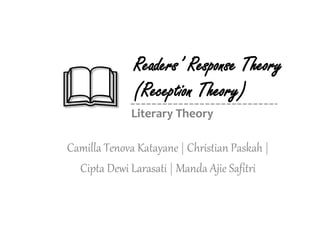
Readers
- 1. Camilla Tenova Katayane | Christian Paskah | Cipta Dewi Larasati | Manda Ajie Safitri Readers’ Response Theory (Reception Theory) Literary Theory
- 2. What’s in this PowerPoint? • What is Readers’ Response? • The history of Readers’ Response • The concept
- 3. To start with… • Go to your presentation group. • Listen to this song. • After you listen to this song, please discuss: – What is the theme of this song? Tell your interpretation of the song. • Be ready to present this in front of the class.
- 4. So, you’ve done the Readers’ Response Theory! • Do you still need us anymore?
- 5. What Kind of Food is Readers’ Response Theory?
- 6. So, this is it. • Readers’ Response Theory (or you can say it as Reception Theory) is a theory that allows INFERENCES and READERS’ POINT OF VIEWin understanding a literary work. • These things will affect your interpretation: – Background knowledge – Time – Emotion
- 7. How to use Readers’ Response Theory? (discussion) • You can go to your group and discuss these questions according to the song you’ve heard. – What do you feel about the song? – How does the song agree or disagree with your point of view? – How well does the song address things that you personally care about and consider important in the world? Cite specific lines from the song. – Do you connect this song with something that you remember? Cite lines from the song and explain the connection. – What is your overall reaction to the song?
- 8. How to use Readers’ Response Theory? • Be ACTIVE(it’s a must!) because you give meaning to the work. • You have to READ and CONTEMPLATE the content of the literary work (you will involve your emotion through this. Trust us!) • After you read and contemplate the literary work, you have to state your perspective towards the literary work.
- 9. The Historical Development of Readers’ Response Theory
- 10. Here is the story behind this Reception Theory. • In 1930, students and authors are disenchanted due to the ‘death’ of the readers in interpreting the literary work. • In 1938, Louise Rosenblatt thought that criticism should involve “personal sense of literature” and your “spontaneous and honest reaction”.
- 11. People behind this theory are…(1) • Edmund Husserl • He is well-known for his theory: ‘phenomenon’. • Phenomenon: appearances of things, or things as they appear in our experience, or the ways we experience things, thus the meanings things have in our experience
- 12. • Hans Robert Jauss • He is well-known for his theory: horizon of expectation. • Horizon of expectation: expectation about literary work brought by the reader based on experience, background knowledge, and experience. People behind this theory are…(2)
- 13. • Wolfgang Iser • He is well-known for ‘the affective structure of the text’. • …in considering a literary work, one must take into account not only the actual text but also the actions inolved in responding to that text. • …reading is an active and creative process, it is reading which brings the text to life, which unfold its inherently character. People behind this theory are…(3)
- 14. • Martin Heidegger • His theory is called ‘existential time’. • …time is something unique to particular person’s consciousness; a person’s life, her traversing of the journey between birth and death, is most fundamentally constituted by time. People behind this theory are…(4)
- 15. • Stanley Fish • …meaning is not somehow contained in the text but is created within the readers’ experience. People behind this theory are…(5)
- 16. Readers’ Response Theory Background Knowledge Experience You have to be actively involved. Time So…
- 17. • Ask before you are confused. Did we make ourselves clear?
- 18. Gracias.